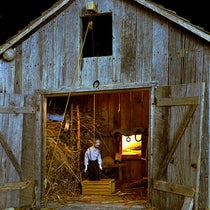Scientist of the Day - John Edward Gray
John Edward Gray, an English zoologist, died Mar. 7, 1875, at the age of 75. John was a sickly child - indeed, by his own account, he was confined to a chair for 8 months out of the year – and he found solace and occupation in the study of animals. He secured a job as an assistant in the Department of Zoology at the British Museum in 1824, when he was 24 years of age. His brother George Robert, younger by 8 years, was also a naturalist, and healthier, so he was somewhat more successful in his career, at least at first. George was placed as an ornithological assistant in the Zoology Department in 1831. When Charles Darwin returned from the Beagle voyage in 1836 and was farming out his specimens to various experts, he handed his birds over to John Gould at the British Museum, but when Gould ran off to Australia, Darwin turned to George for assistance in finishing his book, which George provided, and which Darwin gratefully acknowledged in the preface to the Birds volume (1841) of the Zoology of the Beagle (1839-42). George, in turn, asked Darwin if he would write a letter recommending his brother John for the position of Keeper of Zoology, when that position opened up in 1840. Darwin did so, and John Edward got the job. It was the second of three incidents or episodes that link Darwin and John Gray in the history of zoology. The first was their birthday of Feb. 12, which they shared.
In the fall of 1846, Darwin had finished with all the specimens from the Beagle voyage save one – a tiny pinhead of a burrowing barnacle that he had found in a conch shell in Chile over ten years earlier. Darwin called it “Mr. Arthrobalanus.” He knew little about barnacles, but his new friend Joseph Hooker suggested that this might be a field he could make his own. Darwin wrote to every person or institution that might have barnacles he could study, and one of the individuals who received an inquiry was John Edward Gray, who had himself done some work on barnacles in the 1820s. He, like Hooker, encouraged Darwin to undertake a detailed study of barnacles, since they were not so much misunderstood as not understood at all, Only recently had they been moved out of the class of Mollusks into the class of Crustacea, where they now nestled as the sub-class Cirripedia. Gray added that he would gladly give up his own work on barnacles if Darwin would take in on. Convinced, Darwin set out on a new zoological adventure.
To compile such a work, Darwin needed specimens to study and dissect. You cannot name and describe a species if you don’t have the type specimen right there on your bench or on the glass slip under your microscope. Darwin acquired many barnacle specimens on his own, and borrowed others from collectors he knew, but the greatest collection of barnacles lay relatively untouched in the British Museum. So on Dec. 28, 1847, Darwin wrote John Edward Gray a remarkable letter. He brazenly asked, not if he could use the museum collection of barnacles, but if he could borrow it – if it could be sent in large lots to his house in Down, so that he could dissect at least one individual of each of the hundreds of species. The specimens would eventually be returned, not all of them exactly intact, although Darwin did promised to return the dissected animals preserved in spirits.
Gray did not have the authority to grant such a request, but he did forward Darwin’s letter to the Trustees, along with a cover letter of his own, attesting to Darwin’s high reputation and integrity and explaining why Darwin needed to examine the specimens at his house. The trustees granted the request, and Darwin embarked on what would turn out to be an 8-year study that would result in 4 printed volumes – two on living barnacles and two on fossil species – still the definitive monograph on Cirripedia, the production of which transformed Darwin from an amateur naturalist into an expert zoologist. All the Museum barnacles were eventually returned, as Darwin had promised. We displayed one volume of A Monograph on the Sub-class Cirripedia (1851-54) in our exhibition, The Grandeur of Life (2009), where we showed a plate depicting familiar barnacle secreted exteriors, as well as a detailed diagram made by Darwin of the living organism inside, in this case the acorn barnacle Balanus. Here we show a different plate (third image), depicting a variety of body parts of the female sessile barnacle Cryptophialus minutus. The tiny individual at bottom right was the specimen that got Darwin started, "Mr. Arthrobalanus," the tiny male mate of the female Cryptophialus; we can see it better in a detail (fourth image).
The portrait of Gray (first image) was drawn on a lithographic stone by Thomas Herbert Maguire in 1851 and is one of the Ipswich Museum series of portraits executed by Maguire. We discussed this series briefly in our post on John Henslow last month.
William B. Ashworth, Jr., Consultant for the History of Science, Linda Hall Library and Associate Professor emeritus, Department of History, University of Missouri-Kansas City. Comments or corrections are welcome; please direct to ashworthw@umkc.edu.










